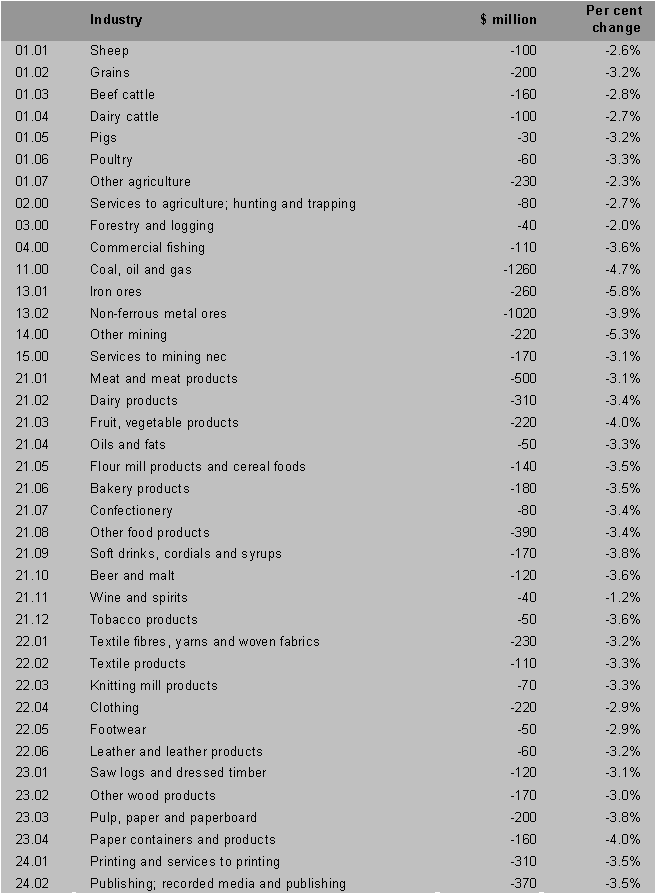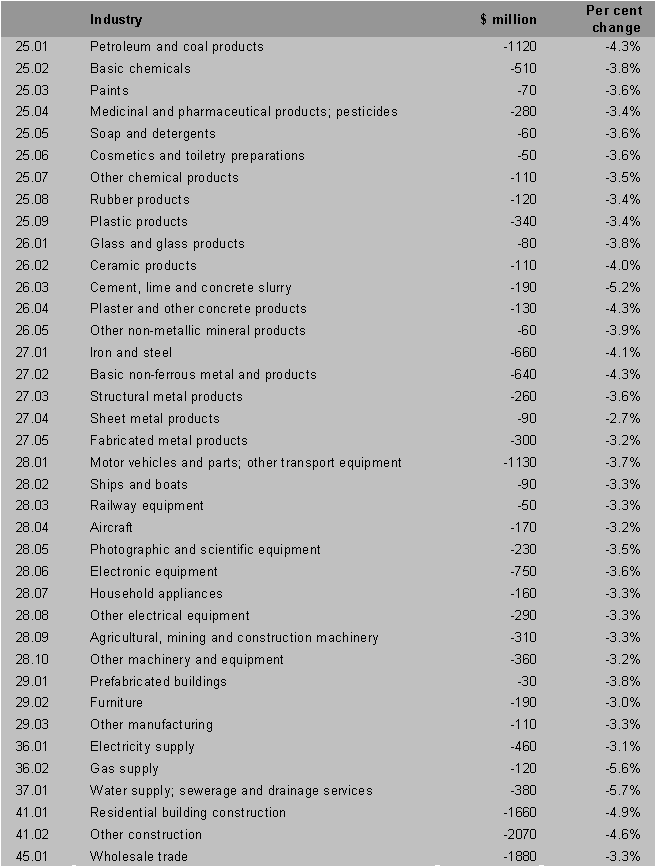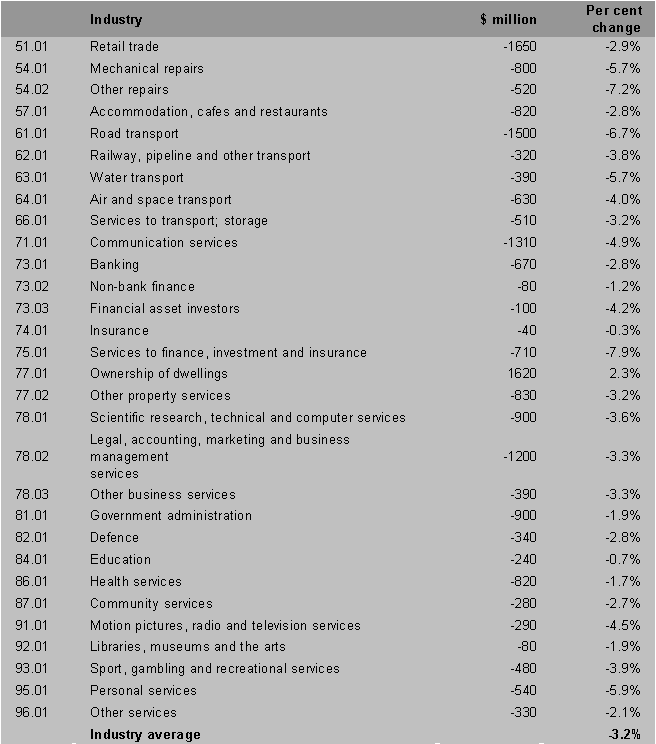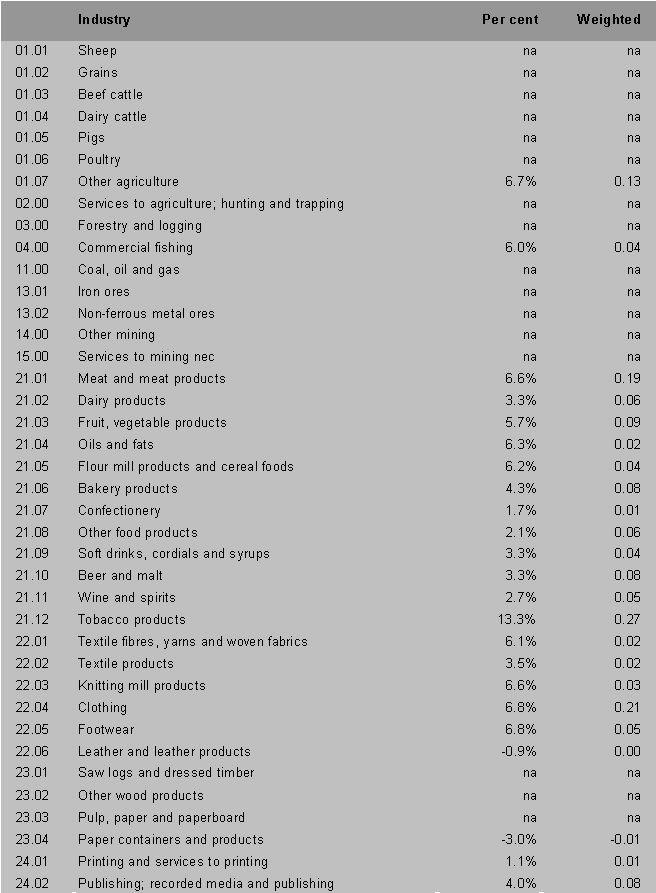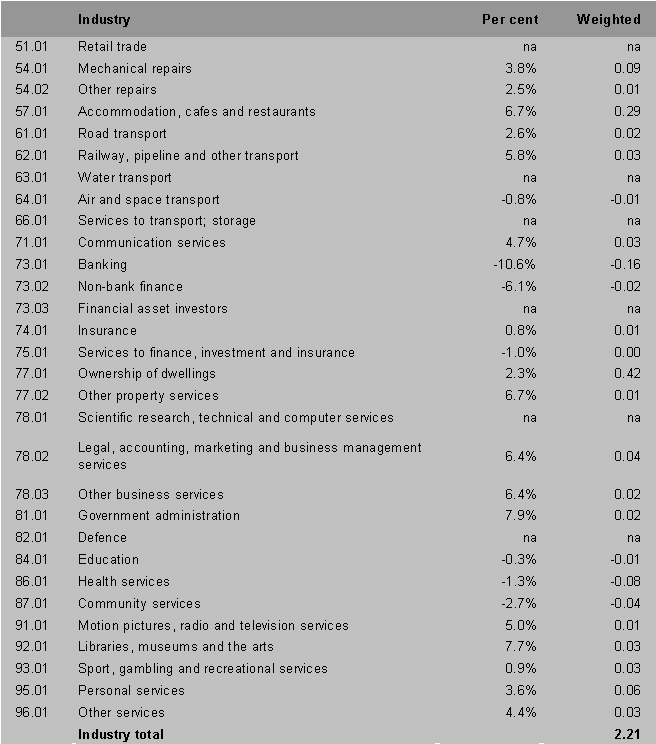The impact of the Government's reforms
Overview |
The tax reform package will bring significant benefits to individuals and families. It will also enhance economic growth and job creation, and completely transform Commonwealth-State financial relations. The reform will be accomplished within the confines of the Government's medium-term fiscal strategy.
The tables that follow summarise the economic effects of reform. In addition, they present cameos illustrating the impact of the reform package on many different household types. All of the cameos show that the personal income tax cuts and the increases in social security and family benefits exceed the impact of indirect tax reform on the cost of living, based on the expected increase in the population-wide Consumer Price Index (CPI). |
Benefits for the economy
The fiscal impact
The tax reform package has been designed to be consistent with the Government's medium-term fiscal strategy.
The package will be implemented progressively from 1999-00 and will reduce the size of the Commonwealth surplus projected for that year and subsequent years. The package has a significant fiscal cost (somewhat less than one per cent of GDP annually) but will bring substantial benefits to the operation of the economy and to the sustainability of both Commonwealth and State government finances. Reflecting the considerable improvements in Government fiscal policy in recent years, the tax package can be accommodated while retaining sizeable Budget surpluses as required by the fiscal strategy.
The budgetary position of the States will, over time, be enhanced considerably by the package. In 2000-01, however, the States are projected to have insufficient goods and services (GST) revenue to cover the budgetary cost of all of the other elements of the package, reflecting transitional costs and short-term timing effects. However, the package allows for the Commonwealth's commitment that the States will be no worse off in budgetary terms during the three-year transitional period (to 2002-03) - after which the States will be in a much stronger position, reflecting that GST revenue will grow at an appreciably stronger rate than the Commonwealth grants and State taxes that it is replacing.
In costing the package, the Commonwealth's three-year transitional commitment is assumed to be met by Commonwealth grants in 2001-02 and 2002-03 together with a short-term interest free advance in 2000-01, repayable in the following year.
The broad economic impact
The tax reform package will deliver substantial long-term improvements in the operation of the economy, to the benefit of all Australians.
These improvements will be reflected in higher economic growth as a result of stronger, more productive, investment which, together with the lowering of industry costs, will yield better export outcomes. Such changes will be crucial in relaxing the balance of payments constraint that has for so long held back Australia's growth performance. The combination of higher growth and improved work incentives will deliver more jobs and lower unemployment.
Key elements of the package that will drive higher growth are:
- lower effective income tax rates, lifting incentives to work and save;
- lower, less distorted, industry input costs lifting export profitability and performance;
- abolition of distorting indirect taxes;
- a reformed business tax system, lifting capital productivity;
- lower tax compliance costs, freeing highly skilled resources for more productive endeavour; and
- more secure government finances, removing the need for ad hocery in tax design.
While difficult to measure, these economic growth benefits will be substantial, as shown by a range of independent studies under various assumptions and for somewhat different packages. For example, a 1998 report prepared by the Melbourne Institute of Applied Economic and Social Research in partnership with the Brotherhood of St Laurence and the Committee for Economic Development in Australia (titled Tax Reform: Equity and Efficiency) finds that indirect tax reform alone can increase GDP by about 3- per cent in the long run. Another 1998 study by Salamon Smith Barney Stockbrokers found that indirect tax reform could increase GDP by about 2 per cent in the long run. These findings are consistent with the range of results reported in a 1988 OECD study (OECD, 1988, Tax Reform in OECD countries: Motives, Constraints and Practice, in OECD Economic Studies No. 10, Spring 1988).
In the short-term, the package might be expected to have transitional effects upon both demand (particularly its pattern) and prices.
The pattern of demand in the economy is likely to change in the period immediately preceding and following the introduction of the tax reform package. To the extent that consumption decisions are discretionary, some expenditure is likely to increase before implementation of a GST as consumers bring forward consumption in anticipation of higher prices. Other expenditure will be deferred. In contrast, investors may defer expenditure in the expectation of lower prices for investment goods and business may run down their stocks. While the pattern of demand may change in the transition phase, the overall effects on economic activity during this period are likely to be small and dominated by the fiscal stimulus inherent in the package.
Overall, prices in the economy are likely to be broadly unchanged following the introduction of the reform package. This overall effect would reflect a small one-off rise in the overall prices of consumption goods and services, offset by a fall in the prices of investment goods. These relative price changes - and those within consumption expenditures - must be allowed to occur to bring about the more efficient allocation of resources flowing from the more neutral (less distorting) indirect tax system. Similarly, some small relative wage effects may occur.
But policies will need to be set to ensure that there are no on-going i
nflationary effects, as would occur were there to be demands for generalised wage increases. There is, of course, no case for such increases as wage earners will be more than fully compensated for consumption price increases by income tax cuts and increases in government benefits - their real take home pay will actually rise.
Hence policies will need to be set to accommodate some or all (depending on the circumstances at the time) of the small one-off increase in consumer prices but not to permit further flow through. This should be achieved readily in a continuing low inflation environment and given the enhanced credibility of monetary policy that has flowed from the Government's ensuring Reserve Bank independence.
Against this background, and the improved cost structures inherent in the package, the introduction of a GST is unlikely to lead to an increase in inflationary expectations and on-going inflation. This assessment is supported by international experience.
The impact on industry costs and consumer prices
Table 5.1 presents, for a number of broad industry categories, the estimated impact of the indirect tax package on costs of production and final consumer prices. A more detailed table is provided at the end of this chapter.
The impact is to reduce industry costs by an average of 3.2 per cent.
Table 5.1:
Impact of tax reform on industry costs and
consumer prices (costs in 2000-01 values)
Industry category |
Impact on industry costs |
Impact on consumer prices |
|
|
(%) |
($m) |
(%) |
|
| Agriculture |
-2.8 |
-1,140 |
6.5 |
| Mining |
-4.4 |
-2,970 |
na |
| Food |
-3.4 |
-1,910 |
4.4 |
| Beverages |
-3.0 |
-350 |
3.1 |
| Tobacco |
-3.6 |
-60 |
13.3 |
| Textiles, clothing and footwear |
-3.1 |
-750 |
5.9 |
| Wood, paper, chemicals and construction products |
-3.8 |
-6,620 |
0.8 |
| Motor vehicles |
-3.7 |
-1,150 |
-8.3 |
| Other transport equipment |
-3.2 |
-320 |
na |
| Other equipment and manufacturing |
-3.4 |
-2,480 |
>-1.8 |
| Electricity, gas and water |
-4.1 |
-970 |
5.2 |
| Construction |
-4.7 |
-3,740 |
na |
| Wholesale and retail trade |
-3.1 |
-3,510 |
na |
| Mechanical and other repairs |
-6.2 |
-1,330 |
3.6 |
| Accommodation, cafes and restaurants |
-2.8 |
-830 |
6.7 |
| Transport and storage | -4.8 |
-3,270 |
1.6 |
| Communications |
-4.9 |
-1,300 |
4.7 |
| Finance, property and business services |
-3.2 |
-4,990 |
-1.9 |
| Ownership of dwellings |
2.3 |
1,620 |
2.3 |
| Public administration and defence |
-2.1 |
-1,310 |
7.9 |
| Community services |
-1.4 |
-1,13%0 |
-1.3 |
| Cultural, recreational and personal services |
-3.6 |
-1,720 |
2.5 |
| All industry average |
-3.2 |
2.2* |
|
* The price impacts relate to the private final consumption expenditure deflators. This compares with a CPI effect of 1.9 per cent.
Some industries benefit from larger cost reductions than others. The costs facing the road transport industry, for example, fall substantially (by some 6.7 per cent) due to the removal of wholesale sales tax and the diesel excise reforms.
Even in the banking and financial services sector, which is largely input taxed under the GST, costs are expected to fall. What this means is that there are sufficient wholesale sales tax, excise and other taxes embedded in the costs of banking and financial services that applying a 10 per cent GST to a large share of their inputs will actually cost them less. For this sector, it is estimated that the cost of intermediate (materials) purchases will fall by about $700 million a year (2000-01 values). The annualised cost of investment goods used in the industry is expected to fall by some $900 million a year. Other tax reductions, including stamp duties, will reduce costs by an additional $600 million a year while the GST will add about $600 million a year to industry costs. In sum, the costs facing the banking and financial services industries are expected to fall by some $1.6 billion a year despite this sector being input taxed under the GST.
The prices of most items purchased by consumers are expected to rise as a result of the indirect tax reforms contained in the package. However, some prices will fall. For example, the prices paid by consumers for things like motor vehicles, electrical equipment, health services and pharmaceutical products should be lowered by tax reform. The 2.3 per cent increase in price of the commodity produced by the ‘ownership of dwellings’ industry (ie rents) arises from the GST applying to new houses, renovations and additions, repairs and other costs involved in home ownership. But this impact will be dampened by the new First Home Owners' Scheme, which more than compensates for the increase in the prices of new houses (up to $150,000) and has the effect of reducing the overall price increase for housing services from 2.3 per cent to 0.7 per cent. The latter figure is used in the modelling of the distributional impacts of the reform package. The impact on tobacco prices is ignored in that modelling (see below).
Table 5.2 reports the ‘deflators’ (ie change in average prices) for each category of final demand (other than ‘stocks’). The cost of supplying exports is found to fall by nearly 3.5 per cent, or about $4.5 billion in 2000-01 values. And the cost of private investment is found to fall by nearly 7 per cent.
Table 5.2:
Impact of tax reform on the cost of final demand
Category of final demand |
(%) |
| Private final consumption expenditure |
2.2 |
| Government final consumption expenditure |
-2.0 |
| Private investment |
-6.9 |
| Government business enterprise investment |
-4.5 |
| General government investment |
-4.5 |
| Exports |
-3.5 |
The impact of tax reform on the cost of government purchases is significant. Overall, it is estimated that the costs of government will be reduced by more than $1 billion a year.
An explanation of the modelling approach
Treasury's Price Revenue Incidence Simulation Model (PRISMOD)
Impacts on industry costs, consumer prices and the revenue implications of indirect tax reform have been obtained from Treasury's PRISMOD. This is a large scale, highly disaggregated model of the Australian economy. It contains a very highly detailed specification of the Australian National Accounts (ANA), incorporating all of the detail of inter-industry flows captured in the input-output tables produced by the Australian Bureau of Statistics.
PRISMOD models 107 industries purchasing about 1,200 inputs and selling their product to other industries and seven categories of final demand: private final consumption expenditure (households); government final co
nsumption expenditure (governments); private investment (private businesses); government business enterprise investment; general government investment; stocks and exports (non residents). Indirect taxes are specified at this level of detail.
Price changes are estimated for each of the 107 industry outputs. The estimated price changes for the 107 industries can be used to calculate the price impact on private final consumption expenditure. However, many people are interested in changes in the official CPI, not changes in the price of private final consumption expenditure. The 107 industry outputs are quite different to the 108 expenditure classes used to calculate the official CPI. However, the 107 industries can be mapped across to the 108 CPI expenditure classes to allow a calculation of the change in CPI. When the mapping is done it turns out that the estimated CPI impact of the tax reform package (excluding its impact on tobacco) is very close to its impact on the ANA concept of private final consumption expenditure (but including the impact on tobacco prices).
Key features of the model
In technical jargon, PRISMOD is a price input-output model. This means that it focuses on the inter-industry transmission of price changes. For example, it tracks how a change in price of diesel fuel impacts on all industries that purchase diesel, and on all industries that purchase from those industries, and on all purchasers of those industries and so on.
PRISMOD ignores quantity (output) changes - only price impacts are modelled. That is, businesses are assumed to continue to operate with exactly the same inputs, and produce exactly the same outputs, before and after the change being simulated.
Another important feature of the modelling is that all cost and price impacts are passed on fully to final purchasers (eg governments and households). For example, it is assumed that the abolition of the wholesale sales tax would be passed through fully to consumers in the form of lower prices. Similarly, it is assumed that lower transport costs due to cheaper diesel for road and rail transport are passed through in lower prices for consumers. And it is assumed that the GST is passed through in the form of higher prices for consumers. On the other hand, it is considered very unlikely that exporters would receive lower world prices for their products simply because their costs fall as a result of tax reform. Instead, the assumption is that lower costs for exporters will be reflected in a moderately stronger exchange rate over time. These incidence assumptions are standard in this sort of modelling.
PRISMOD says nothing about the timing of price change. All of the price impacts calculated by the model are ‘long run’ in nature. The experience of other countries is that most of the price impacts of major indirect tax reform flow through within the first twelve months.
Benefits for households
An explanation of the cameo approach
The cameos draw together the effect of the various measures in the reform package to provide details of the overall impact on individuals and families at the point of implementation.
The cameos that follow show, for different household types and different levels of private income, the personal income tax cuts and the increases in family benefits and social security payments that such households will receive. Private income is the income that households receive from non-government sources, before income tax is taken out. It includes income from employment, interest, dividends, rental property income and so on. Disposable income is calculated by subtracting income tax from private income and then adding government cash payments (pensions and benefits, including family payments). The cameos assume that private income is unaffected by the tax reform package. But disposable income is affected because of personal income tax cuts and increases in government cash payments. These measures ensure that disposable incomes increase at all levels of private income.
From the increases in disposable incomes, the increases in the cost of living associated with the net effect of indirect tax reform are then deducted to calculate the extra ‘cash in hand’ that each household will have.
In all cases the cameos assume that individuals and families who satisfy the income test criteria for family and social security assistance also meet all other relevant eligibility and residence requirements and, hence, receive that assistance. They are based on the projected values of family and social security assistance in July 2000 under the pre-tax reform arrangements, compared to the projected July 2000 values after the tax reform package.
How was the increase in cost of living calculated?
Using population-wide cost of living
The increase in the cost of living associated with the introduction of the tax reform package is calculated using the estimated population-wide CPI increase of 1.9 per cent in 2001-02. This figure has been used to adjust the cost of living of each household group. This is consistent with the longstanding arrangements which adjust the value of social security payments for inflation, based on movement in the population-wide CPI. It needs to be noted, however, that the 1.9 per cent CPI increase excludes the impact of the tax package on tobacco prices. This reflects the Government's view that the impact of the GST on tobacco prices should not, for public health reasons, be offset by income tax cuts and/or increases in social security payments. The 1.9 per cent CPI takes account of the new First Home Owners' Scheme's offsetting the impact of the GST on new house prices.
Alternative methodologies are flawed
The population-wide CPI describes an average impact across different households. Some researchers will want to use different cost of living measures for different household groups. However, disaggregating the population-wide CPI among different households is not desirable. Those researchers who have attempted to do so in the past have used Australian Bureau of Statistics (ABS) data from the Household Expenditure Survey (HES). Certain features of the HES invalidate its being used in this way.
This is because of the adjustments made by the ABS in order to calculate weights for the CPI - these adjustments assure a better CPI but, without them, the HES data contain biases. For example, adjustments are made for known cases of under reporting (eg tobacco and alcohol) and some expenditure estimates (eg some consumer durable items) are subject to high sampling errors and are adjusted using other data on expenditure levels.
The HES is conducted over a full year to take account of seasonal variations in expenditure. Household expenditure for each household is based on two weekly personal diaries and, to minimise sampling error, on information provided on a recall basis for periods up to two years on items purchased infrequently, such as household appliances and motor vehicle registration and insurance. It is not appropriate to draw statistical inferences from individual household records in the survey. It is only through the aggregation process that seasonal and other irregular variations in expenditure patterns are ironed out.
Some researchers modify the raw HES unit record data set by discarding ‘outliers’. This practice is actually more likely to reduce the quality of the HES data. The reason is that this will lead to a downward bias in the expenditure estimates for those variables that have produced the ‘outliers’. Furthermore, it will have an affect on other expenditure variables as the ‘outliers’ typically come from households with large expenditures.
The issue of different cost of living measures for d
ifferent household groups has been examined in detail by the ABS. They concluded, in the publication Feasibility of Constructing Price Indexes for Special Population Groups (Catalogue No. 6445.0) that there was almost no difference in the overall price increase each household group faced over a period of eleven years — despite prices rising by 120 per cent over that period.
For these reasons, governments have consistently adopted the practice of providing compensation for price increases by adjusting benefits by the movement in the population-wide CPI.
Disposable income is the better measure
The increase in the population-wide CPI is applied to household disposable income rather than to household consumption in calculating the increase in the cost of living. The cost of living estimate is therefore a measure of the change in value of real disposable income. This technique has the effect of ignoring differences in saving ratios among households. This is consistent with the approach of many researchers who take the view that current consumption (in a particular week, month, or even year) provides a less reliable measure than disposable income of a household's ability to consume. And it is a household's ability to consume that is really of interest, since that is what is affected by cost of living changes.
There is a more pragmatic reason for basing the cameo calculations on disposable income, rather than current consumption. While there is a National Accounts measure of average household saving, there are no reliable data on the saving rates of different types of households. For example, the HES, which has sometimes been used for such purposes, does not contain reliable data of this sort - a point that the ABS emphasises with each survey release.
However, some comment can be made on the significance of the approach for the data in the cameos. Those who would prefer to see cost of living calculations based on current consumption will presumably want to argue that, to the extent households spend less than their total income (ie save), the cost of living increases reported here will be overstated and, hence, the cash gains are understated. They will also take the view that, to the extent households spend more than their income (ie dissave), the cost of living increases will be understated. Making such adjustments, however, would have an imperceptible effect on the cameos - especially as the population-wide household saving rate is about 5 per cent.
Calculating the benefits for pensioners
As noted in Chapter 1, in July 2000 pensioners and beneficiaries will receive an up-front payment increase of 4 per cent. Table 5.3 shows the projected value of the age pension in July 2000, before and after the up-front adjustment.
Table 5.3:
July 2000 adjustments to age pensions
Single pensioners |
$/fortnight |
| Projected pension before 4% adjustment |
384.50 |
| Projected pension after 4% adjustment |
400.00 |
| Pension increase |
15.50 |
Pensioner couples |
$/fortnight |
| Projected pension before 4% adjustment |
642.00 |
| Projected pension after 4% adjustment |
667.50 |
| Pension increase |
25.50 |
In addition to the up-front 4 per cent increase in pensions and benefits, the Government will ensure that over time the increase is maintained at 1 percentage points above the actual impact of the tax reform package on the CPI. The effect of the 1 per cent real increase is illustrated in the cameos for pensioners and beneficiaries.
What isn't covered in the cameos?
There are a number of factors not covered in the cameos. Most importantly, they do not cover the efficiency and macroeconomic benefits to Australia from tax reform.
The Government's package of reforms creates a tax system to take Australia into the twenty-first century. Tax reform is being undertaken to make the economy work better; so as to promote higher economic growth and higher living standards (see studies referred to earlier in this chapter) — not to redistribute the tax burden. But gains from higher growth are not easy to measure. Additional gains will accrue to the economy, under this package, through more effective taxing of the ‘cash economy’.
It is not possible to calculate the distribution of these gains to particular types of households. As a result, the cameos do not attempt to capture, for example, the benefit to a family which now decides that it is worth getting a job, rather than relying on government assistance, or the benefits from the increased employment opportunities and income associated with the shift of investment from artificial tax minimisation schemes into genuinely productive enterprises such as construction or tourism.
In addition, the cameos do not capture the impact of measures designed to crackdown on loopholes and make people pay their fair share. These include: greater taxation compliance arising from the GST and more effective income tax administration; and changes to Fringe Benefits Tax, including the reporting of fringe benefits over $1,000 on employee Group Certificates. They also do not include the effect of the childcare reforms, the benefits of the new private health insurance initiative, or the introduction of refundable imputation credits.
The benefits estimated
The 107 industries presented in the tables that follow correspond to those used in the Australian National Accounts, Input-Output Tables (ABS Catalogue No. 5209.0). Industries 01.01 to 04.00 represent agriculture; 11.00 to 15.00 are the mining industries; 21.01 to 37.01 are the manufacturing industries; 41.01 and 41.02 are the construction industries; and 45.01 to 96.01 are the services industries.
Not all of the 107 industries supply product directly to household consumers. For example, none of the mining industries do so, and very little of the output of the agricultural industries is consumed by households in the form in which it leaves the agricultural producer. Similarly, households do not directly consume the output of the ‘residential building construction’ industry (41.01). Instead, these industries supply their product to other industries that in turn supply goods and services to households.
For example, sheep are sold largely to the ‘meat and meat products’ industry (21.01). In the process, transport and other costs of distribution are added. The ‘meat and meat products’ industry sells to retailers who then sell to consumers. Again, transport and other costs of distribution are added along the way. PRIS
MOD captures all of these costs.
A further illustration is provided by the ‘water, sewerage and drainage’ industry (37.01). Its output is purchased as an intermediate (materials) input to most other industries. About half of its output is purchased by the ‘ownership of dwellings’ industry (77.01). The price paid by households for water, sewerage and drainage services is therefore reflected in the cost of the product supplied by the ‘ownership of dwellings’ industry. So too is most of the household consumption of paints (25.03). ‘Ownership of dwellings’ is the industry that supplies housing services to renters and owner-occupiers. The output of the ‘ownership of dwellings’ industry is a flow of services consumed by these two groups. In the Australian National Accounts, this is how the housing costs of consumers are represented. As noted earlier, the effective increase in price of this industry's output is reduced from 2.3 per cent to 0.7 per cent once account is taken of the First Home Owners' Scheme.
Most of the 107 industries produce a large number of different products consumed by households. For example, the ‘fabricated metal products’ industry (27.05) produces things like cutlery, metal hand tools for gardening, nails, screws, metal blinds and awnings, firearms and television antennae. Because different products will typically face different WST treatment (and may even face different treatment under the GST), it is difficult to predict from the tables the precise impact of tax reform on the prices of individual products. This means that considerable caution should be exercised in using the tables.
For example, the price of products produced by the ‘dairy products’ industry (21.02) is estimated to increase by 3.3 per cent. But this is really an average of price changes for a large group of different products including things like ice cream (which is expected to fall in price) and plain milk (which is expected to increase in price). Similarly, the price of the ‘other services’ industry (96.01) is estimated to go up by 4.4 per cent. This industry includes religious services. But it would clearly be wrong to conclude that the price of religious services will go up by that amount since religious services will be GST-free. A better indicator of the likely price change for religious services is given by the reduction in costs facing the ‘other services’ industry (ie a reduction of 2.1 per cent).
The price impacts of reform are presented in their original form as well as on a weighted basis to indicate the contribution each industry makes to the aggregate price impact on private final consumption expenditure of 2.2 per cent (only marginally different from the estimated CPI impact of 1.9 per cent).
Cost effects (by industry) of indirect tax reform
Cost effects (by industry) of indirect tax reform (continued)
Cost effects (by industry) of indirect tax reform (continued)
Note on housing costs
The estimated 2.3 per cent increase in the cost of the output of the ownership of dwellings industry is due to the GST treatment of new houses. The First Home Owners' Scheme more than compensates for the increase in the price of new houses (up to $150,000 excluding land) and reduces the overall effective price increase experienced by consumers of housing services (renters and owner-occupiers) from 2.3 per cent to 0.7 per cent.
Price effects (by industry) of indirect tax reform
Price effects (by industry) of indirect tax reform (continued)
Price effects (by industry) of indirect tax reform (continued)
Note on housing costs
The estimated 2.3 per cent increase in the cost of the output of the ownership of dwellings industry is due to the GST treatment of new houses. The First Home Owners' Scheme more than compensates for the increase in the price of new houses (up to $150,000 excluding land) and reduces the overall effective price increase experienced by consumers of housing services (renters and owner-occupiers) from 2.3 per cent to 0.7 per cent.
The cameos - at a glance
The cameo tables at the end of this chapter provide a detailed estimate of the impact of the new tax system on household types. All of the cameos show that the personal income tax cuts and the increases in social security and family benefits exceed the impact of indirect tax reform on the cost of living, based on the estimated increase in the population-wide CPI.
The tax reform package restores equity to the tax system. The new income tax scale concentrates tax cuts on middle income earners. Those with incomes between $38,000 and $50,000 will find their marginal tax rate cut by 13 percentage points, from 43 per cent to only 30 per cent. Some 81 per cent of taxpayers will face a marginal tax rate of 30 per cent or lower. Lower income earners are also major beneficiaries of the increase in the tax free threshold and the cut in the lower marginal rates from 20 per cent to 17 per cent and from 34 per cent to 30 per cent. The gains to higher income earners are capped by the maintenance of the 47 per cent top marginal rate. This means that a person with an income of $200,000 (or even $1,000,000) receives the same tax cut (the same dollars per week) as a person with an income of $75,000.
The large increases in family benefits are also concentrated on middle income families. Middle income families gain the most from the tax reform package. In fact, the cameos understate the true gains for families beyond July 2000. This is because they do not allow for the impact of the normal annual indexation arrangements for family assistance. These will increase family assistance over time by the amount of the increase in the CPI due to tax reform. That is, the discrete increases in family assistance illustrated in the cameos in July 2000 will actually be established as ongoing real increases.
The following provides a brief explanation of the factors underpinning some of the cameo results.
Single person
At low levels of private income, people gain from the real increase in social security payments, as such people would be eligible for Newstart Allowance.
Between the private income levels of $14,800 and $20,700 the gain in disposable income drops (but remains positive) because of the combined effect of:
- the social security income test applying over a longer range of income than occurs under the current system (due to the increased adequacy of allowances); and
- the second lowest statutory marginal tax rate applying to an individual's income slightly earlier than occurs under the current system.
The signific
ant increases in disposable income that occur thereafter are due to the lower marginal tax rates. The gains are maximised (in percentage terms) at $75,000, due to the unchanged marginal rate of 47 per cent applying from that income level.
Dual income couple with no dependent children
At low levels of income these families benefit from the real increase in social security payments and the reduction in the first marginal tax rate to 17 per cent.
Between private family income levels of around $27,000 and $30,000 the gain in disposable income falls (but remains positive). The larger benefit at income levels below this range is due to the social security income test applying over a longer range of income than occurs under the current system due to the increased adequacy of allowances.
For couples with equally shared incomes, the significant increase in the net cash gain between the private family income levels of $76,000 and $80,000 arises from the second marginal tax rate (now 30 per cent) applying to an individual's income for a longer range of income than occurs under the current system (ie up to $50,000 a year for each individual, rather than $38,000).
Single income couples with dependent children
Families in this situation receive significant increases in disposable income, due to the combined effect of the tax cuts and families package.
The significant increases in disposable income that occur between the private family income levels of $17,000 and $35,000 (higher where there is more than one child) arise from the income tax cuts, the substantial easing of the income test for family assistance (which is designed to improve work incentives) and the increased levels of assistance for families. The gains are greatest where there is a child aged under 5 years in the family, due to the $350 a year extra increase in assistance for such families.
The increases in disposable income between the private family income levels of $69,000 and $83,000 (higher if there is more than one child in the family) arise from the income tax cuts and the relaxation of the income tests for the various family assistance measures within the current system.
Sole parents
Sole parents receive significant increases in disposable income at all income levels.
At low levels of income, they benefit from increases in social security payments and a large boost in family assistance.
The significant increases in disposable income between the private family income levels of $19,000 and $35,000 (for one child) arise from the income tax cuts, the substantial easing of the income test for family assistance (which improves work incentives) and the increased level of assistance for families.
The increases in disposable income between the private family income levels of $69,000 and $83,000 (for one child) arise from the income tax cuts and the relaxation of the income tests for the various family assistance measures within the current system.
Dual income couples with dependent children
These families gain from the new tax system at all levels of combined family income, due to the combined effect of the tax cuts and the families package.
The significant increases in disposable income between the private family income levels of $27,000 and $35,000 (for one child) arise from the income tax cuts, the substantial easing of the income test for family assistance (which is designed to improve work incentives) and the increased levels of assistance for families.
The increases in disposable income between the private family income levels of $69,000 and $83,000 (for one child) arise from the income tax cuts and the relaxation of the income tests for the various family assistance measures within the current system.
Age pensioners
The significant increase in disposable income that occurs for pensioners over most of the income range is due to the increased adequacy of pensions and the more generous pension rebate and pension income test.
There is a fall-off in (but still positive) net cash gain between the private income levels of $23,000 and $28,600 ($38,000 and $48,000 for couple pensioners). This is because the relaxed pension income test results in some people becoming newly eligible for a part-rate pension at income levels within these ranges. The amount of pension these people receive reduces as their income increases, thereby reducing the increase in disposable income.
Self-funded retirees
At low levels of private income (ie less than $13,000 a year for single people and $21,000 for couples) self-funded retirees do not pay tax under the current or new systems. However, they gain from the Aged Persons Savings Bonus (which is assumed to generate an investment income of 5 per cent) and from the Self-Funded Retirees Supplementary Bonus of $200 a year for ten years (paid as a lump sum of $2,000).
Beyond $13,000 (or $21,000), self-funded retirees gain from the tax cuts, including the increase in the tax rebate for low income aged people. Some also gain from the increase in the cut-out point for the age pension that results from the relaxation of the pension income test. In addition, lower income self-funded retirees who own shares gain from the introduction of refundable franking credits and many self-funded retirees benefit from the new private health insurance initiative, with some offset due to the removal of the savings rebate - these effects are not included in the cameos.
The Cameos
| How do cuts in tax and changes to benefits affect me? Single Person |
|

Notes:
- 3,723,000 income units are covered by this cameo.
- Does not include impact of private health insurance tax rebate/benefit or the removal of the savings rebate.
- The cost of living adjustment is based on a population wide CPI.
| How do cuts in tax and changes to benefits affect me? Sole Parent with one dependent child aged under 5 years |
|

Notes:
- 63,000 income units are covered by this cameo.
- Does not include impact of private health insurance tax rebate/benefit or the removal of the savings rebate.
- The cost of living adjustment is based on a population wide CPI.
| How do cuts in tax and changes to benefits affect me? Sole Parent with two dependent children, one aged under 5 years |
|

Notes:
- 44,000 income units are covered by this cameo.
- Does not include impact of private health insurance tax rebate/benefit or the removal of the savings rebate.
- The cost of living adjustment is based on a population wide CPI.
| How do cuts in tax and changes to benefits affect me? Single income couple with no dependent children |
|

Notes:
- 460,000 income units are covered by this cameo.
- Does not include impact of private health insurance tax rebate/benefit or the removal of the savings rebate.
- The cost of living adjustment is based on a population wide CPI.
| How do cuts in tax and changes to benefits affect me? Single income couple with one dependent child aged under 5 years |
|

Notes:
- 114,000 income units are covered by this cameo.
- Does not include impact of private health insurance tax rebate/benefit or the removal of the savings rebate.
- The cost of living adjustment is based on a population wide CPI.
| How do cuts in tax and changes to benefits affect me? Single income couple with one dependent child aged between 5 and 13 years |
|

Notes:
- 122,000 income units are covered by this cameo.
- Does not include impact of private health insurance tax rebate/benefit or the removal of the savings rebate.
- The cost of living adjustment is based on a population wide CPI.
| How do cuts in tax and changes to benefits affect me? Single income couple with two dependent children one aged under 5 years |
|

Notes:
- 136,000 income units are covered by this cameo.
- Does not include impact of private health insurance tax rebate/benefit or the removal of the savings rebate.
- The cost of living adjustment is based on a population wide CPI.
| How do cuts in tax and changes to benefits affect me? Single income couple with two dependent children aged between 5 and 13 years |
|

Notes:
- 166,000 income units are covered by this cameo.
- Does not include impact of private health insurance tax rebate/benefit or the removal of the savings rebate.
- The cost of living adjustment is based on a population wide CPI.
| How do cuts in tax and changes to benefits affect me? Single income couple with three dependent children one aged under 5 years |
|

Notes:
- 62,000 income units are covered by this cameo.
- Does not include impact of private health insurance tax rebate/benefit or the removal of the savings rebate.
- The cost of living adjustment is based on a population wide CPI.
| How do cuts in tax and changes to benefits affect me? Dual income couple (50%:50% income split) with no dependent children |
|

Notes:
- 1,278,000 income units are covered by this cameo.
- Does not include impact of private health insurance tax rebate/benefit or the removal of the savings rebate.
- The cost of living adjustment is based on a population wide CPI.
| How do cuts in tax and changes to benefits affect me? Dual income couple (50%:50% income split) with one dependent child aged under 5 years |
|
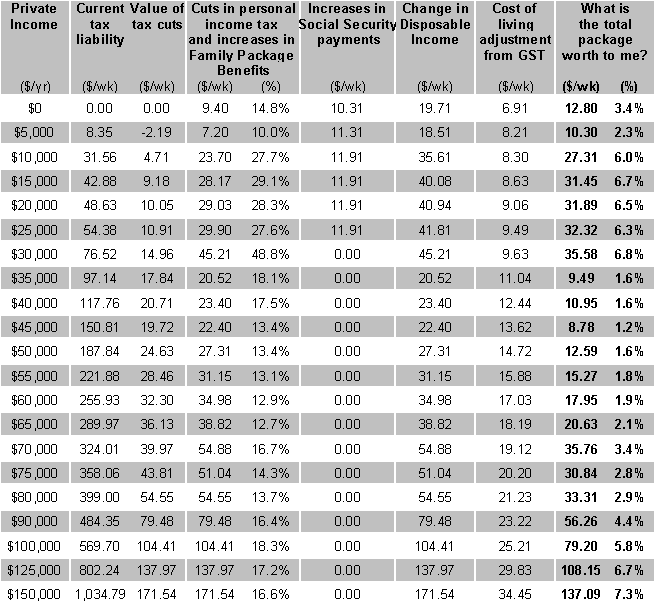
Notes:
- 131,000 income units are covered by this cameo.
- Does not include impact of private health insurance tax rebate/benefit or the removal of the savings rebate.
- The cost of living adjustment is based on a population wide CPI.
| How do cuts in tax and changes to benefits affect me? Dual income couple (50%:50% income split) with one dependent child aged between 5 and 13 years |
|
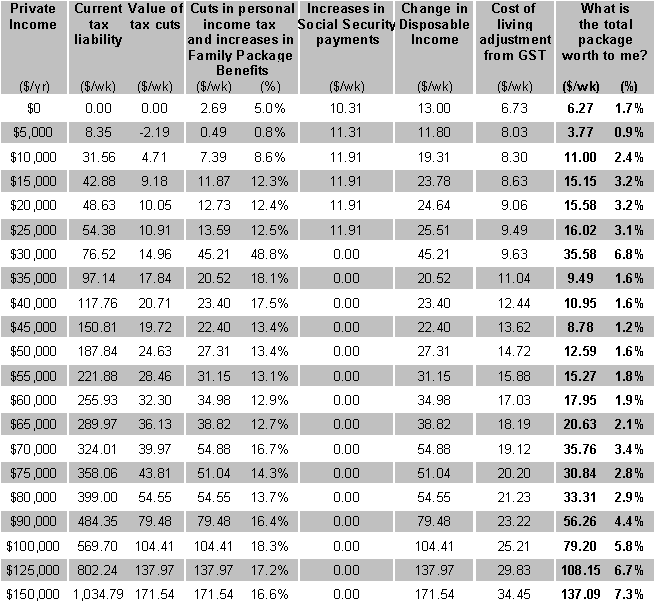
Notes:
- 333,000 income units are covered by this cameo.
- Does not include impact of private health insurance tax rebate/benefit or the removal of the savings rebate.
- The cost of living adjustment is based on a population wide CPI.
| How do cuts in tax and changes to benefits affect me? Dual income couple (50%:50% income split) with two dependent children, one aged under 5 years |
|
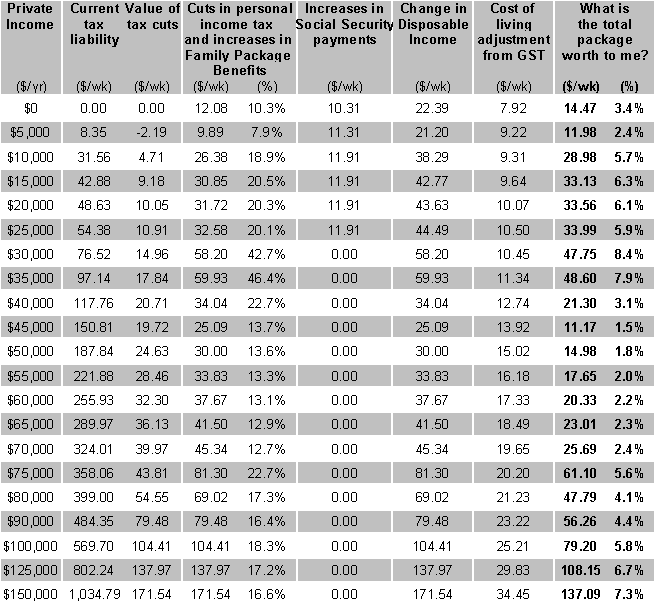
Notes:
- 125,000 income units are covered by this cameo.
- Does not include impact of private health insurance tax rebate/benefit or the removal of the savings rebate.
- The cost of living adjustment is based on a population wide CPI.
| How do cuts in tax and changes to benefits affect me? Dual income couple (50%:50% income split) with two dependent children aged between 5 and 13 years |
|

Notes:
- 341,000 income units are covered by this cameo.
- Does not include impact of private health insurance tax rebate/benefit or the removal of the savings rebate.
- The cost of living adjustment is based on a population wide CPI.
| How do cuts in tax and changes to benefits affect me? Dual income couple (50%:50% income split) with three dependent children, one aged under 5 years |
|
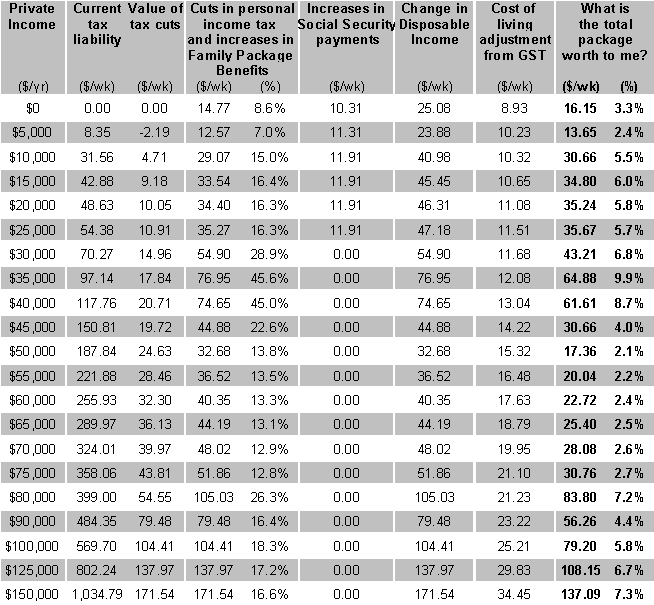
Notes:
- 61,000 income units are covered by this cameo.
- Does not include impact of private health insurance tax rebate/benefit or the removal of the savings rebate.
- The cost of living adjustment is based on a population wide CPI.
| How do cuts in tax and changes to benefits affect me? Dual income couple (67%:33% income split) with no dependent children |
|

Notes:
- 1,278,000 income units are covered by this cameo.
- Does not include impact of private health insurance tax rebate/benefit or the removal of the savings rebate.
- The cost of living adjustment is based on a population wide CPI.
| How do cuts in tax and changes to benefits affect me? Dual income couple (67%:33% income split) with one dependent child aged under 5 years |
|

Notes:
- 131,000 income units are covered by this cameo.
- Does not include impact of private health insurance tax rebate/benefit or the removal of the savings rebate.
- The cost of living adjustment is based on a population wide CPI.
| How do cuts in tax and changes to benefits affect me? Dual income couple (67%:33% income split) with one dependent child aged between 5 and 13 years |
|

Notes:
- 333,000 income units are covered by this cameo.
- Does not include impact of private health insurance tax rebate/benefit or the removal of the savings rebate.
- The cost of living adjustment is based on a population wide CPI.
| How do cuts in tax and changes to benefits affect me? Dual income couple (67%:33% income split) with two dependent children, one aged under 5 years |
|

Notes:
- 125,000 income units are covered by this cameo.
- Does not include impact of private health insurance tax rebate/benefit or the removal of the savings rebate.
- The cost of living adjustment is based on a population wide CPI.
| How do cuts in tax and changes to benefits affect me? Dual income couple (67%:33% income split) with two dependent children aged between 5 and 13 years |
|

Notes:
- 341,000 income units are covered by this cameo.
- Does not include impact of private health insurance tax rebate/benefit or the removal of the savings rebate.
- The cost of living adjustment is based on a population wide CPI.
| How do cuts in tax and changes to benefits affect me? Dual income couple (67%:33% income split) with three dependent children, one aged under 5 years |
|
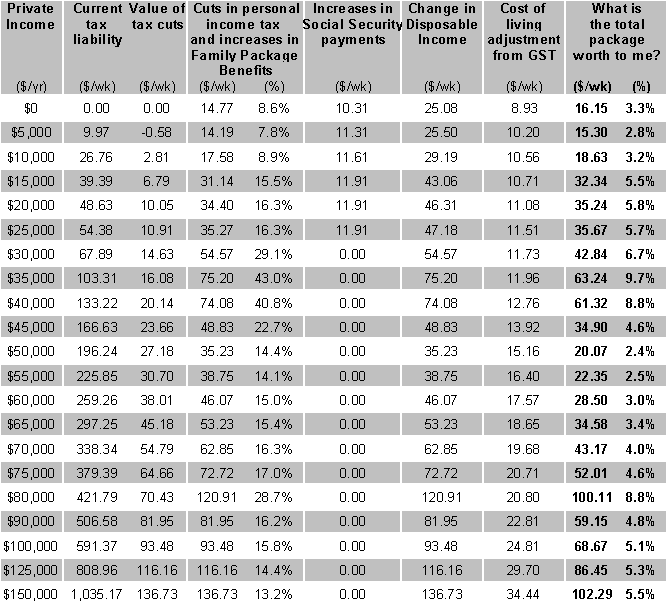
Notes:
- 61,000 income units are covered by this cameo.
- Does not include impact of private health insurance tax rebate/benefit or the removal of the savings rebate.
- The cost of living adjustment is based on a population wide CPI.
| How do cuts in tax and changes to benefits affect me? Single age pensioner |
|
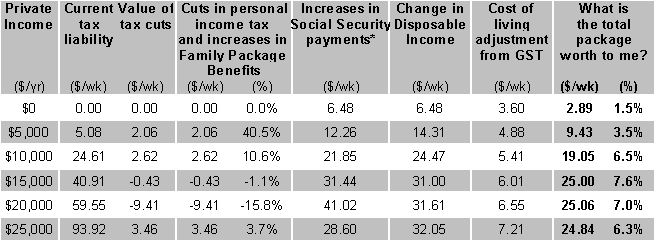
*Includes Aged Persons Savings Bonus
Notes:
- 895,000 income units are covered by this cameo.
- Does not include impact of private health insurance tax rebate/benefit or the removal of the savings rebate.
- The cost of living adjustment is based on a population wide CPI.
| How do cuts in tax and changes to benefits affect me? Age Pensioner Couple (50%:50% income split) |
|

*Includes Aged Persons Savings Bonus
Notes:
- 626,000 income units are covered by this cameo.
- Does not include impact of private health insurance tax rebate/benefit or the removal of the savings rebate.
- The cost of living adjustment is based on a population wide CPI.
| How do cuts in tax and changes to benefits affect me? Single self-funded retiree |
|

*Includes Aged Persons Savings Bonus
Notes:
- 69,000 income units are covered by this cameo.
- Does not include impact of private health insurance tax rebate/benefit or the removal of the savings rebate.
- The cost of living adjustment is based on a population wide CPI.
| How do cuts in tax and changes to benefits affect me? Self-funded retiree couple (50%:50% income split) |
|

*Includes Aged Persons Savings Bonus
Notes:
- 70,000 income units are covered by this cameo.
- Does not include impact of private health insurance tax rebate/benefit or the removal of the savings rebate.
- The cost of living adjustment is based on a population wide CPI.
